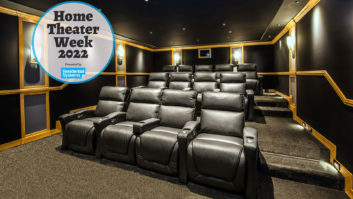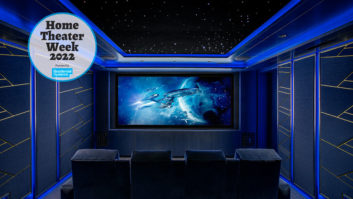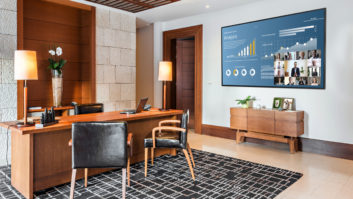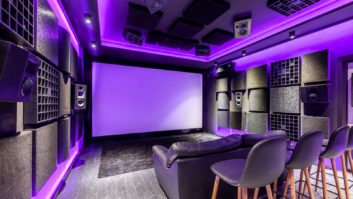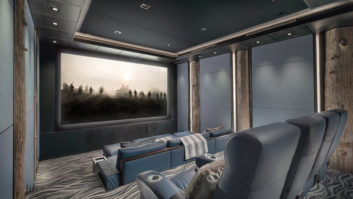Most of the home theater systems that my company designs and installs are much more modest than the full-blown, industry-standard screening rooms that some of our entertainment industry clients hire us to provide. When given adequate budget and space, we have been able to create private screening rooms that have matched the finest industry rooms and far exceeded most local cinemas. The best of these rooms include both 35mm film and large-format video projection systems. Our understanding of what goes into building uncompromised, professional screening rooms has made a huge difference in our approach to designing even basic home theater systems.
I would like to review some of the specific parameters and goals that can help make a home theater deliver the most cinematic experience possible.
A controllable multi-aspect masking system is a standard feature for all pro screening rooms, where projecting images that do not perfectly match the visible area of the screen is simply not done. A projected image has more impact and increased contrast when there is no exposed screen material adjacent to the active area on the screen. For our clients who are not sure if the extra investment is worthwhile, all we have to do is show them the same image with and without precise masking and they almost always go for the masking.
Recently, we have been enjoying the simplicity and flexibility of the new Stewart Filmscreen Directors Choice system, which includes four separately adjustable panels, combined with a dual-processor system that allows setting and recalling presets with any combination of mask positions. A really cool feature is that when combined with the Kaleidescape disc-based DVD video server, the Directors Choice masking system will automatically adjust to the dimensions of every movie selected. For more modest systems, we employ only side masking.
Most screening rooms include curtains that cover the screen when not in use. We try to enroll our clients in this idea, but we are not able to succeed as often as we would like.
When it comes to trying to emulate the movie experience with a video system, front projection is the only way to go.
Rear-projection and flat-panel displays just cant transport the viewer to the cinema like front projection can. And now that we can get spectacular image quality out of relatively inexpensive DLP projectors, such as the Marantz for $13,000 list, the only reason not to go with front projection is due to installation constraints or the inability to control ambient light. The Marantz projector and a 110-inch diagonal projection screen cost less than a good 61-inch plasma monitor, and there really is no comparison in terms of the viewing experience.
The best theatrical experience results from the projector being installed in a projection booth, or at least behind glass in a rear wall or enclosure of some kind. Not only is this approach closer to the cinema experience, but fan noise is very distracting during the quiet passages in movies.
For the true feel and experience of high-impact cinema sound, the only way to go is professional horn-based speakers. I would never consider such a system primarily for music, nor would I consider home stereo speakers for a high-end home theater. There are different speakers, designed for different purposes. Our current first choice is Meyer Sound Labs.
We offer a full acoustical treatment package to our clients, engineered and installed to precisely control the soundstage, imaging and low-frequency response of the room. This upgrade results in a substantial improvement in the performance of the systems and the experience of movies and music in the room. One company we like is ARS. Their finishes can be any of a wide range of fabric wall systems, and they provide a full turnkey service.
Just how important is furniture to the performance of a home theater or screening room? We think very important.
Specialized theater seating can really enhance the experience of the room. We design the seating to allow each row to recline to the appropriate angle for each row for optimum viewing. For clients who are looking for maximum impact, low-frequency transducers or shakers can be mounted in the seats themselves.
When given the opportunity, we design tiered seating and ceilings, further enhancing the theatrical experience. We always recommend that the door or doors be located at the rear of the room to minimize light spill on the screen and distraction should someone need to leave or enter the room during the movie.
Separate HVAC zoning is a must for proper comfort. If there is a projection booth, it should be on its own zone as well. There is nothing worse than a cool day resulting in hot air being pumped into a small room full of hot A/V components. Also, we try to make sure that plumbing is not installed in any of the walls to minimize distracting noise.
One key to designing spectacular home theaters is to emulate, as much as possible, screening room designs. Sometimes just a few good decisions can make a world of difference, not all of them being costly to implement.



